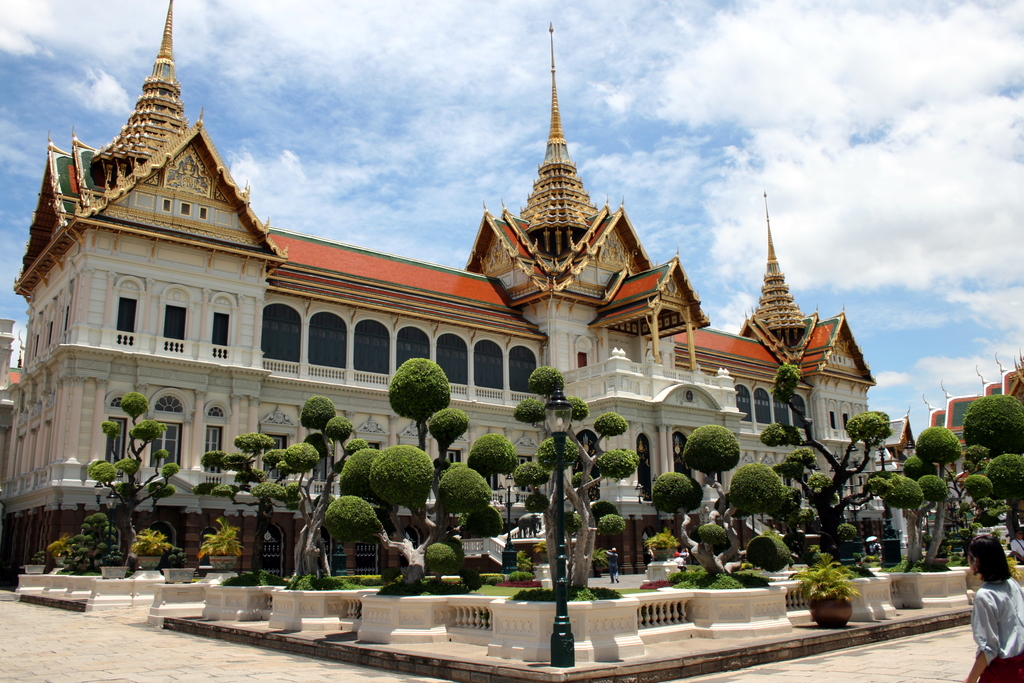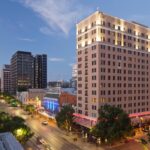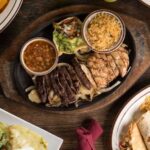When you explore the vivid streets of Bangkok, the Grand Palace Bangkok in Thai is a name that resonates with the echoes of a grandiose past. Known to locals as พระบรมมหาราชวัง or Phra Borom Maha Ratcha Wang, this architectural wonder articulates the glory of Thailand’s bygone era. Erected in the heart of the city, this historic symbol intricately unveils the story of Thailand’s heritage, presenting an awe-inspiring tapestry of royal legacies, meticulous artistry, and undying cultural significance.
Since its inception in 1782, the Grand Palace has been a pivotal site, resonating with the life and vibrancy of the Thai monarchy. With its illustrious courtyards and ornate halls, each corner of the complex is a masterpiece, offering insights into the nuanced blend of traditional Thai and European designs. Whether you’re a history aficionado or a connoisseur of culture, the Grand Palace is a testament to the indefatigable spirit of Thailand’s identity and grandeur
An Overview of the Grand Palace Bangkok

As you delve into the heart of Thailand, the Grand Palace Bangkok stands as a monumental symbol of the country’s royal legacy and architectural brilliance. This historical residence has been the official residence of the Kings of Siam since its construction, reflecting the culture and history of the nation.
The Historical Significance of the Grand Palace
The Grand Palace is not merely a breathtaking vision but a cornerstone of Thai history. Initially established by King Rama I, it marked the shift of the capital city to Bangkok and quickly became the epicenter of the royal and administrative life. This site has been the official residence for subsequent leaders, cementing its status as one of the most significant tourist attractions in the city.
Architectural Design and Structure
The aesthetics of the Grand Palace reflect a rich blend of tradition and innovation. With its asymmetrical layout and eclectic array of styles, the complex tells the story of a past in which each king left his mark in the forms of various expansions and renovations, particularly King Chulalongkorn, whose contributions are evident in the current facade. The distinctive design elements encapsulate the diversity and adaptability of the nation’s past architectural endeavors.
Current Status and Access for Tourists
Today, the Grand Palace remains a functioning palace, frequently hosting official events. However, parts of the palace have been converted into a museum that is open to the public, allowing visitors from around the world to explore the rich heritage of this historical residence. Whether it’s the intricate murals or the lavish throne halls, every corner of the Grand Palace Bangkok in Thai offers a glimpse into the splendor of the erstwhile official residence of the Kings of Siam.
Understanding the Grand Palace’s Past
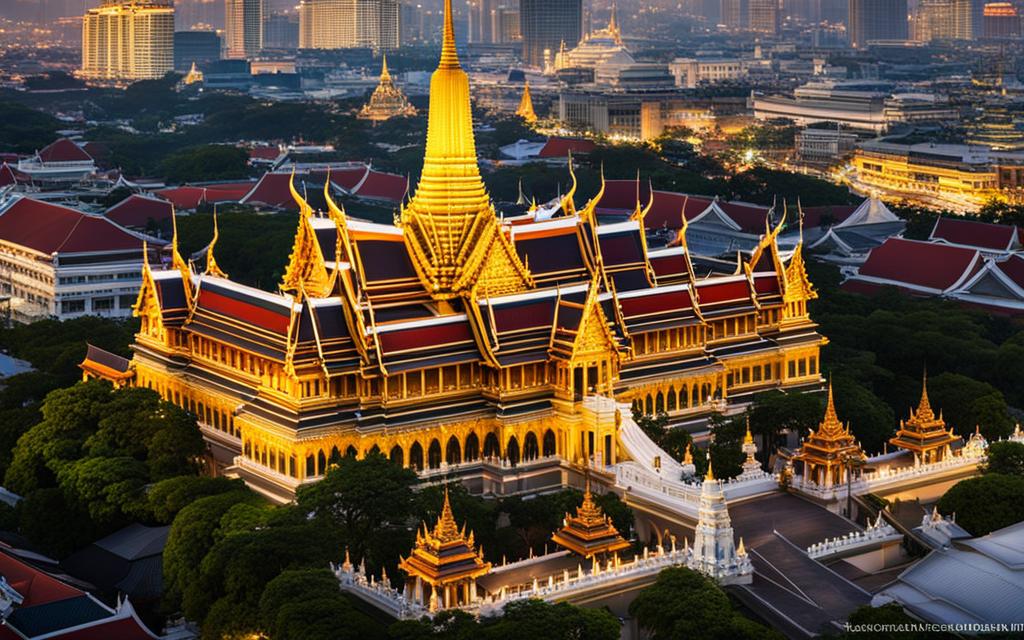
The Grand Palace of Bangkok is not only a symbol of Thailand’s architectural ingenuity but also a testament to the enduring legacy of the Chakri dynasty. Your journey through its corridors is a step back in time to the very inception of the royal lineage that continues to influence Thai culture and governance.
Founding by King Phutthayotfa Chulalok (Rama I)
King Phutthayotfa Chulalok, also known as Rama I, is credited with the critical task of establishing the Grand Palace back in 1782. This strategic move was more than mere construction; it signified the beginning of Bangkok’s history as the new capital and confirmed the might of his nascent reign. Here, the wooden pillars of the original structures stood as the embodiment of the kingdom’s aspirations and its monarch’s vision. This monumental event marked the start of an era and the creation of a legacy that would resonate through centuries.
Succession of Monarchs and the Palace’s Role
As each monarch ascended to the throne, they too contributed to the canvas of the Grand Palace. The complex we see today, brimming with history, is the sum of contributions from each king of the Chakri dynasty. With additions and renovations, they continually shaped both the physical and metaphysical contours of Thailand’s royal legacy.
| Monarch | Contributions to the Grand Palace | Impact on Royal Legacy |
|---|---|---|
| Rama II | Expansion and construction of additional structures | Enhanced the Palace’s capacity as a hub for royal ceremonies and governance |
| Rama IV | Modernization of the palace architecture with Western influences | Signaled Thailand’s progressive stance during a period of increasing Western influence |
| Rama V | Major overhauls and the introduction of new residential spaces | Fostered a renaissance in Thai culture and national identity |
| Rama VI | Further modernization and the introduction of public works | Integrated the Palace further into the lives of the Thai people |
Despite the physical departure of the royal residence from Bangkok in 1925, the spirit of the Chakri dynasty reverberates within the walls of the Grand Palace. It remains a core of the nation’s identity, preserving the significant traces of each monarch’s rule. As you explore, remember that every stone and every carving tells a piece of the grand narrative of Thailand’s royal lineage.
Cultural and Ceremonial Importance of the Palace
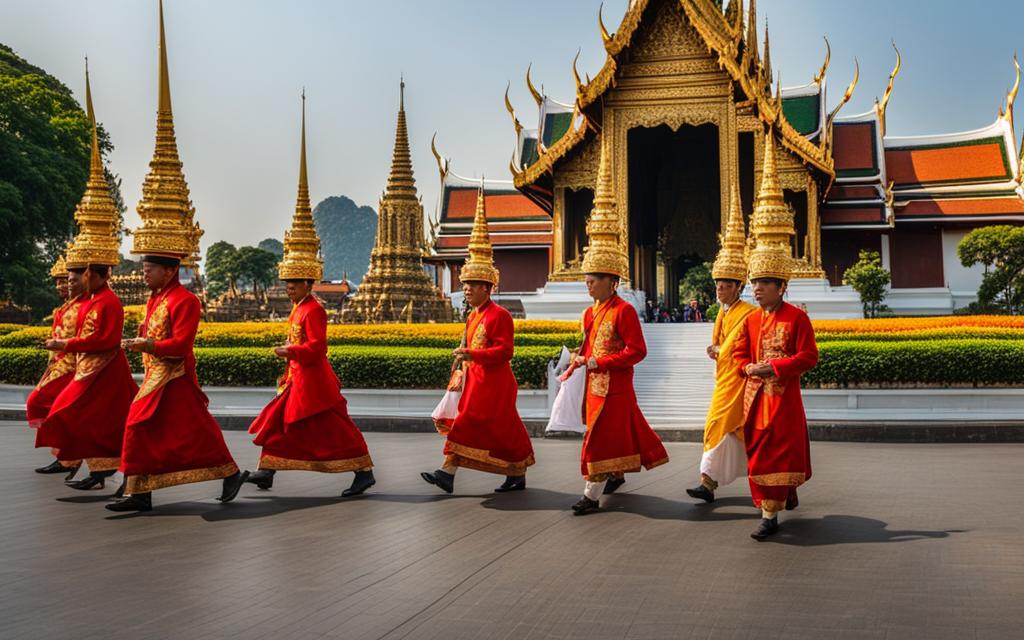
The Grand Palace, an emblematic structure in the heart of Bangkok, serves as a testament to the cultural importance of Thai traditions, setting the stage for royal ceremonies and state functions. Beyond the ornate walls and shimmering golden spires lie the stories of a nation, narrated through the ages by the grandeur of these ceremonial events. It is here, within the palace’s boundary, where the weaving of cultural tapestry occurs, preserving the heritage and pomp of Thailand’s storied past.
As you marvel at the palace’s stunning architecture, it’s important to understand that each building, hall, and courtyard has been the backdrop for countless regal events. The vibrant history of the Grand Palace is not merely confined to its physical presence but is alive in the enactment of traditional Thai customs. The continuity of these ceremonies is crucial, as they symbolize the strength and resilience of the kingdom’s identity throughout changing times.
Highlighted below is a glimpse into the kinds of traditional ceremonies and events that underscore the palace’s cultural significance:
- Coronation Ceremonies: A blend of Hindu and Buddhist traditions mark the coronation of Thai kings, a ceremony of cosmic significance to herald the beginning of a new reign.
- Royal Ploughing Ceremony: This ancient rite signals the start of the rice-growing season, with the king or his representative plowing the fields to ensure a bountiful harvest.
- Seasonal Festivals: The palace grounds become a focal point during the traditional Thai New Year (Songkran) and other seasonal celebrations.
These occasions are not just mere rites; they are carefully choreographed events that reinforce the Thai monarchy’s role in society and its position as custodian of the nation’s heritage. So, as you walk through the bustling streets of Bangkok and look upon the tranquil face of the Grand Palace, know that you’re witnessing a monument that is as much about grand architecture as it is about the beating heart of Thai culture—enduring, dynamic, and revered.
Exploring the Grand Palace Grounds
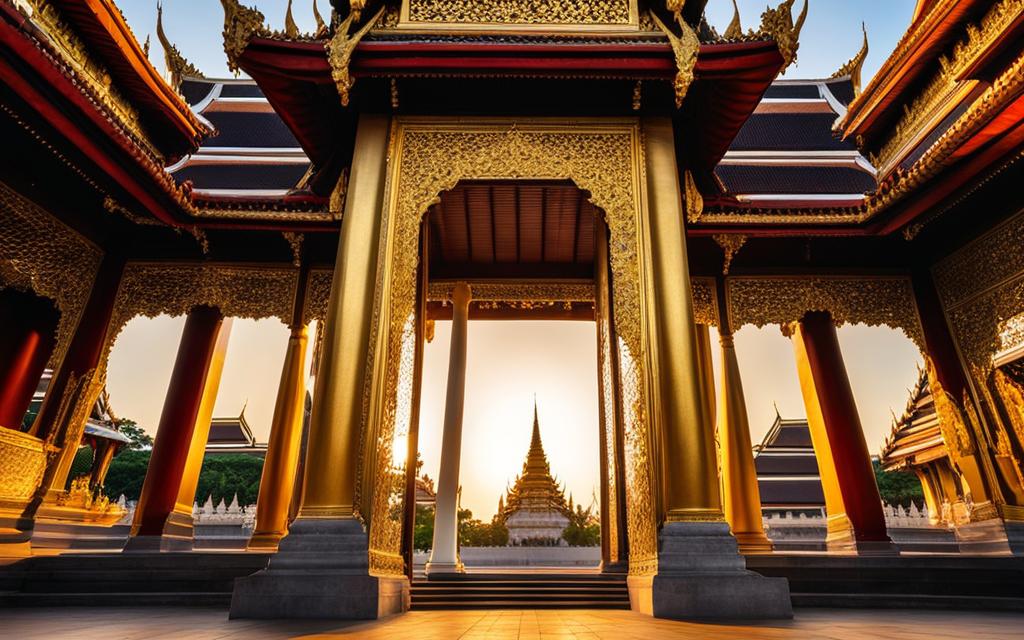
As you embark on a journey through the historic heart of Bangkok, the Grand Palace offers an unparalleled blend of Thailand’s culture and antiquity. Your expedition within these ancient walls takes you through varied zones, each narrating its own story of the past. The vastness of the palace’s layout can be best understood by exploring its two primary areas, the outer court and the inner court.
The Outer Court: Public Buildings and Former Government Sites
The Outer Court Grand Palace, now brimming with historical exploration opportunities, once functioned as the epicenter of administration for the Kingdom. This was where powerful decisions were made and state matters were discussed, with several buildings having been used for governmental purposes. It’s within these quarters that one can sense the thriving pulse of what were once daily affairs of the kingdom.
The Inner Court: Royal Residences and Restricted Areas
In stark contrast to the accessible outer court stands the inner court, an area cloaked in a veil of exclusivity and reserved for Thai royal residences. This section of the Grand Palace was exclusively inhabited by the king’s consorts and daughters, a personal haven incumbent with tales of regal life. Although entry to the inner court is typically restricted, its existence suggests the layers of privacy and luxury afforded to the royal family.
| Outer Court Features | Inner Court Features |
|---|---|
| Temple of Emerald Buddha (Wat Phra Kaew) | Private Royal Apartments |
| Royal Pantheon | Exclusive Residential Gardens |
| Royal Reception Halls | Consorts’ Quarters |
| Former seat of government | Inner Sanctums & Chapels |
Encased within the battlements of the Grand Palace, your exploration leads you across time, offering a glimpse into the intricate weave of Thai monarchy and cultural roots. Whether it’s through studying the architectural mastery or imagining the caliber of events that once transpired here, the Outer Court and Inner Court together stand testament to the grandeur of what was once the axis of a vibrant political and social life.
Grand Palace Bangkok in Thai: A Name Enriched with History
When you delve into the intricate web of Thailand’s historical nomenclature, the grandeur of names becomes apparent. One such name that stands out is Phra Borom Maha Ratcha Wang, the Thai moniker for the Grand Palace in Bangkok. This denomination doesn’t just serve as a geographical indicator but manifests the cultural importance and deep respect the site commands amongst Thais and the global community.
Etymology and Nomenclature
The etymology of Phra Borom Maha Ratcha Wang echoes the richness of naming traditions tied to Thai royalty. Rooted in Sanskrit and Pali, the terms used to pay homage to the divinity and sovereignty associated with the king’s residence. ‘Phra’ suggests the sacred, ‘Borom’ denotes excellency, ‘Maha’ means great, ‘Ratcha’ is indicative of a king, and ‘Wang’ translates to palace. Combined, these words elevate the status of the Grand Palace far beyond its physical structure.
The Name’s Role in Royal Proclamations and Documentation
In eras gone by, the Grand Palace was integrally linked to royal proclamations and state affairs, solidifying its pivotal role in governing and upholding Thai traditions. The reverence associated with its name, Phra Borom Maha Ratcha Wang, has been well documented in historical texts and remains a symbol of pride in contemporary times.
| Term in Name | Meaning in Thai Tradition | Implication on Royal Heritage |
|---|---|---|
| Phra | Sacred | Denotes spiritual reverence to the site |
| Borom | Excellency, divine | Reflects the heavenly stature of the kingship |
| Maha | Great | Implies the vast influence of the royal abode |
| Ratcha | King | Centers the palace as the heart of Thai monarchy |
| Wang | Palace | Establishes the place as royal residence to Thai kings |
The title Phra Borom Maha Ratcha Wang, grand palace Bangkok in Thai, is not merely a name but a celebration of historical and cultural grandiosity preserved through the ages.
Artistic Exhibitions within the Palace Walls
As you venture into the heart of Thailand’s regal heritage at the Grand Palace, you’ll discover a trove of artistry and performance housed within its illustrious confines. This remarkable enclave of culture proudly showcases centuries-old traditions and modern creations alike, exemplified by two prominent cultural hubs: the Arts of the Kingdom Museum and the Sala Chalermkrung Royal Theatre.
Arts of the Kingdom Museum
The Arts of the Kingdom Museum is a spectacular repository of Thai cultural arts, where impeccable royal craftsmanship is on prominent display. Here, the expert hands of village artisans breathe life into exquisite art pieces, all under the auspices of Queen Sirikit’s patronage. Each artifact within the museum’s collection stands testament to the rich creative spirit of the Thai people, embodied in the intricate silverware, delicate Thai silk, and ornate wood carvings that represent tangible pieces of a proud cultural legacy.
Khon Performances and the Preservation of Cultural Arts
The elegance and poise of Thai performance art take center stage in the venerable Khon performances. Synonymous with the classical dance heritage of Thailand, these performances are a feast for the senses with their elaborate costumes, expressive masks, and graceful choreography. Presented at the Sala Chalermkrung Royal Theatre, Khon conveys ancient tales and epic battles from the Ramakien, engendering a deep respect and appreciation for one of the nation’s most beloved forms of cultural expression. Such dedication echoes the ongoing efforts of King Maha Vajiralongkorn to preserve the authenticity and vibrancy of Thai cultural arts for generations to come.
The Temple of the Emerald Buddha: A Sacred Space
When you step into the hallowed grounds of Wat Phra Kaew, commonly known as the Temple of the Emerald Buddha, you are entering one of Thailand’s most sacred spaces. This temple is not just an architectural masterpiece, but it also stands as a pivotal site for devout Buddhist pilgrimage. Inside, the Emerald Buddha – a figurine of profound religious importance carved from a single block of jade – commands reverence and awe.
The significance of this temple extends beyond its stunning visuals; it is a cornerstone of spirituality that has been intricately woven into the fabric of Thai society. Both tourists and pilgrims alike find solace and inspiration within its walls. Below is a table highlighting the key aspects of the Temple of the Emerald Buddha, inviting you to understand its profound impact on Thailand’s cultural and spiritual landscape.
| Aspect | Description |
|---|---|
| Historical Context | This sacred site was established in the 18th century and houses a Buddha image dating back to the 15th century. |
| Spiritual Significance | Considered the palladium of Thai sovereignty, the Emerald Buddha is deeply venerated in Thai culture. |
| Architectural Style | The temple exhibits classic Thai architecture, adorned with intricate carvings and rich decorations. |
| Pilgrimage Importance | Regarded as the most important Buddhist temple in Thailand, it draws millions of pilgrims yearly. |
| Cultural Impact | Wat Phra Kaew encapsulates the essence of Thai religious art and is a symbol of national pride. |
To truly comprehend the temple’s magnificence, one must witness the delicate murals that line its walls, each telling stories from the Hindu epic Ramayana, blending myth with the spiritual ethos of Thailand. As you walk through this devout Buddhist pilgrimage destination, the deep sense of tranquility and reverence is palpable. It is a testament to the enduring devotion and spirituality that permeates throughout the country.
Rules and Recommendations: Planning Your Visit to the Grand Palace
When planning a trip to Bangkok’s renowned Grand Palace, being aware of the local cultural etiquette is essential for a respectful and enjoyable visit. The Grand Palace dress code and ticket information are among the top considerations you should familiarize yourself with before your arrival.
Adhere to the Dress Code: Respecting the Culture
To maintain the dignity of this historic site, visitors are expected to comply with the Grand Palace dress code, which reflects cultural etiquette and sensitivity towards the Thai traditions. Men and women should ensure that they are modestly dressed, with shoulders covered and pants or skirts that extend at least to the knee. It is recommended that you avoid sleeveless tops, short skirts, and tight-fitting clothing to respect the cultural norms of this prestigious monument.
For those who may arrive unprepared, there are often vendors nearby where appropriate attire can be rented or purchased. To prevent any inconveniences and to ensure that dress code infractions do not hinder or delay your experience at the Grand Palace, remember to plan ahead.
Tickets and Timings: Ensuring a Smooth Experience
Adhering to Bangkok visitor guidelines includes being informed about ticket information. Tickets to the Grand Palace can be procured on-site, and it is advisable to arrive early to avoid the long queues that can form, particularly during peak tourist seasons. The ticket grants you access to multiple areas within the complex, including Wat Phra Kaew and the Queen Sirikit Museum of Textiles.
Keep in mind that the Grand Palace’s opening hours are from 8:30 AM to 3:30 PM, so it’s crucial to plan accordingly to maximize your visit. Last entry to the complex is often before the closing hour, so early arrival is encouraged. By paying attention to these details, you ensure a seamless visit filled with appreciation for Thailand’s heritage, free from the concerns of logistical oversights.
Conclusion
Immersing yourself in Thailand’s heritage involves a journey through its heart and soul, where the Grand Palace stands prominently as Bangkok’s iconic landmark. This historic edifice is much more than a mere tourist attraction; it’s a celebrated tapestry of royal history and architectural marvels, capturing the essence of a nation’s pride. Each column carves stories of the past, and every pavilion reflects the harmonious blend of Thai and European design elements, creating a setting that is both visually stunning and historically rich.
Reflecting on the Majesty of Thailand’s Grand Palace
The Grand Palace tour is a passage through time, offering you a glimpse into the opulent lives of past monarchs and the enduring spirit of Thai culture. As you wander the corridors, you encounter the soul of Bangkok—majestic and serene, standing resilient against the tides of time. Its grandeur resonates through the halls, whispering tales of ceremonies and celebrations that have contributed to the rich tapestry that is Thailand’s royal history.
Why the Grand Palace Remains a Must-Visit Destination
Visiting the Grand Palace is more than checking a site off your travel list; it’s about embracing the magnificence of a nation’s identity. Here, amidst this grand, palatial complex, you find yourself in the embrace of Thailand’s cultural inheritance. As a symbol of a vibrant past and a testament to the splendor of centuries-old traditions, the Grand Palace beckons travelers from around the world to witness the legacy of dignity, beauty, and reverence unique to the Thai people.
FAQ
What is the Grand Palace Bangkok in Thai?
The Grand Palace Bangkok is referred to in Thai as พระบรมมหาราชวัง or Phra Borom Maha Ratcha Wang, a name that signifies its historical importance and architectural splendor as a key symbol of Thailand’s heritage.
What is the historical significance of the Grand Palace?
The Grand Palace is the historic symbol and former official residence of the Kings of Siam, reflecting over two centuries of Thailand’s rich royal lineage and governance. It stands as a testament to Bangkok’s history and is now one of the top tourist attractions in the city.
Can you describe the architectural design and structure of the Grand Palace?
The Grand Palace showcases an architectural wonder that blends traditional Thai design with European influences. It features a series of buildings, halls, pavilions, and courtyards, exhibiting an asymmetry and eclectic mix of styles accrued over its 200-year-old evolution.
What is the current status of the Grand Palace and can tourists visit?
Although no longer the permanent royal residence since 1925, the Grand Palace remains a working palace used for official events. Parts of the complex are accessible to the public as a museum, allowing tourists to explore this magnificent historical residence.
Who was the founding monarch of the Grand Palace?
King Phutthayotfa Chulalok, also known as Rama I, was the founding monarch of the Grand Palace. He laid the foundation stone in 1782, during his establishment of Bangkok as the new capital of Siam, marking the commencement of its construction.
How have successive monarchs influenced the role and structure of the Palace?
Successive monarchs of the Chakri dynasty have each contributed to the expansion and enhancement of the Palace. Over time, its role evolved from the mainstay of royal and governmental functions to a ceremonial and cultural site, while its structure expanded to reflect the royal family’s historical prominence and changes in architectural style.
What is the cultural and ceremonial importance of the Grand Palace?
The Grand Palace is central to the cultural importance of Thailand, hosting numerous royal ceremonies and state functions. It is a prominent venue for the celebration of Thai traditions and remains a living symbol of the nation’s storied cultural history.
What can you find in the Outer Court and Inner Court of the Grand Palace?
The Outer Court traditionally housed government offices and public buildings, while the Inner Court was exclusively for the king’s consorts and daughters, serving as royal residences. Today, these areas offer visitors a glimpse into the historical exploration of Thai royalty’s daily life and administration.
How did Phra Borom Maha Ratcha Wang become the name for the Grand Palace?
The name Phra Borom Maha Ratcha Wang was officially given to the Grand Palace during the reign of King Rama IV. The name’s historical nomenclature is steeped in tradition and emphasizes the grandeur of this architectural marvel in Bangkok.
How is the name of the Grand Palace used in royal proclamations and documentation?
The name Phra Borom Maha Ratcha Wang is used in royal proclamations and official documentation to denote the palace’s significant role in the history and administration of the country, distinguishing it as the pivot of royal and governmental endeavors.
What can be seen at the Arts of the Kingdom Museum within the Grand Palace?
The Arts of the Kingdom Museum within the Grand Palace showcases royal craftsmanship, exhibiting remarkable works of art created by the farming communities under Queen Sirikit’s patronage, which have become treasured national heirlooms.
How do Khon performances contribute to the preservation of cultural arts at the Grand Palace?
Khon performances at the Sala Chalermkrung Royal Theatre within the Grand Palace epitomize the preservation of Thai cultural arts. These classical dance performances highlight the continuity of Thailand’s high art form and reflect the royal endorsement of the nation’s rich artistic heritage.
Why is the Temple of the Emerald Buddha significant?
The Temple of the Emerald Buddha, or Wat Phra Kaew, is significant as a sacred space within the Grand Palace complex. It is a devout Buddhist pilgrimage site, housing the revered Emerald Buddha, and is a place of both spiritual and historical importance to Thailand.
What is the dress code for visiting the Grand Palace?
Visitors must adhere to a strict dress code to respect the cultural etiquette of the Grand Palace. This includes wearing conservative clothing that covers arms and legs, reflecting the importance of showing reverence within such a dignified cultural site.
What should visitors know about tickets and timings for the Grand Palace?
It is important for visitors to understand the Grand Palace’s ticket information and operating hours to ensure a smooth experience. Tickets, which grant access to Wat Phra Kaew and the Queen Sirikit Museum of Textiles, are sold onsite, and visitors are advised to check for the latest timings and plan accordingly.
Why is the Grand Palace considered a must-visit destination?
The Grand Palace is considered a must-visit destination because it encapsulates the majesty of Thailand’s regal history and cultural grandeur, offering a unique blend of classic Thai and European architecture, and serving as an iconic landmark that embodies Bangkok’s royal past.

